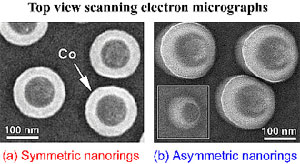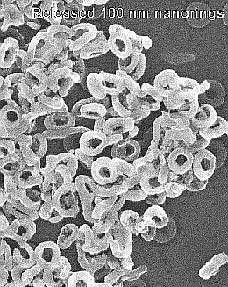| Jan 27, 2006 |
Nanorings could hold key to faster computers
|
|
(Nanowerk News) Researchers at The Johns Hopkins University have discovered that asymmetrical "nanorings" — tiny, irregularly shaped nickel or cobalt rings — can serve as memory cells. Nanorings could be used to create a coin-sized hard drive for computers and bring advantages such as faster operating speeds and consuming much less energy. Doctoral candidates Frank Q. Zhu and Chia-Ling Chien discovered that the nanorings can store a large amount of information, and are resistant to the problem of stray magnetic fields. The production of asymmetrical nanorings would encompass multiple steps involving self-assembly, thin film deposition, and dry etching.
|
|
Imagine a computer that doesn't lose data even in a sudden
power outage, or a coin-sized hard drive that could store
100 or more movies. |
|
Magnetic random-access memory, or MRAM, could make these
possible, and would also offer numerous other advantages.
It would, for instance, operate at much faster than the
speed of ordinary memory but consume 99 percent less
energy. |
|
The current challenge, however, is the design of a fast,
reliable and inexpensive way to build stable and densely
packed magnetic memory cells. A team of researchers at The Johns Hopkins University,
writing in the Jan. 20, 2006 issue of Physical Review
Letters ("Magnetic Bistability and Controllable Reversal of Asymmetric Ferromagnetic Nanorings"), has come up with one possible answer:
tiny, irregularly shaped cobalt or nickel rings that
can serve as memory cells. These "nanorings" can
store a great quantity of information. They also are
immune to the problem of "stray" magnetic fields,
which are fields that "leak" from other kinds of
magnets and can thus interfere with magnets
next to them. Chia-Ling Chien, a professor of physics and astronomy at Johns Hopkins,
headed up the research team. |
 |
Top view scanning electron microscope (SEM) micrographs of (a) symmetric and (b) asymmetric nanorings fabricated from /r/ = 50 nm PS spheres at 0° and 14° / /ion milling angles, respectively. Inset is the composition sensitive SEM image of the ring, bright areas represent Co (Source: Johns Hopkins University)
|
|
"It's the asymmetrical design that's the breakthrough, but
we are also very excited about the fast, efficient and
inexpensive method we came up with for making them," said
paper co-author Frank Q. Zhu, a doctoral candidate in the
Henry A. Rowland Department of Physics and Astronomy in the Krieger
School of Arts and Sciences at Johns Hopkins. |
 |
SEM image of 100 nm symmetric Co nanorings released from substrates that tend to bundle together due to magnetic attraction (Source: Johns Hopkins University)
|
|
The nanorings are extremely small, with a diameter of about
100 nanometers. A single nanometer is one billionth of a
meter. A single strand of human hair can hold 1 million
rings of this size, Zhu says.
|
|
The asymmetrical design allows more of the nanorings to end
up in a so-called "vortex state," meaning they have no
stray field at all. With no stray field to contend with,
Zhu's team's nanorings act like quiet neighbors who don't
bother each other, and thus can be packed extremely
densely. As a result, the amount of information that can be
stored in a given area is greatly increased.
|
|
Fabrication of the nanorings is a multistep procedure
involving self-assembly, thin film deposition and dry
etching. The key to creating asymmetrical rings, Zhu said,
is to — while etching the rings with an argon ion
beam at the end of the process — tilt the substrate
on which the rings are formed.
|
|
"In our previous study, we found that 100 nm symmetric
nanorings have only about a 40 percent chance to get vortex
state," Zhu said. "But the asymmetric nanorings have
between a 40 percent and 100 percent chance to get vortex
state. This chance can be controlled on-demand by utilizing
the direction of magnetic field."
|


